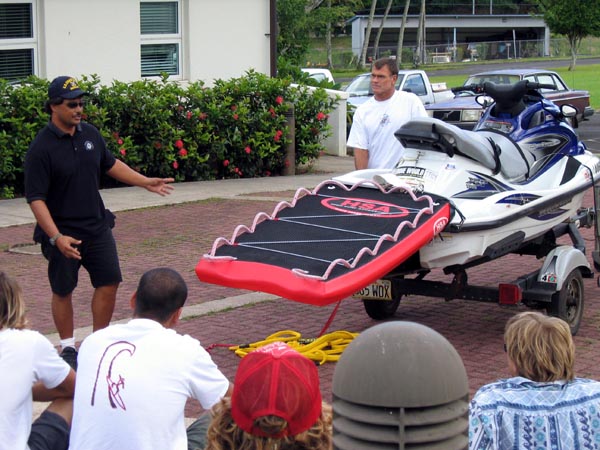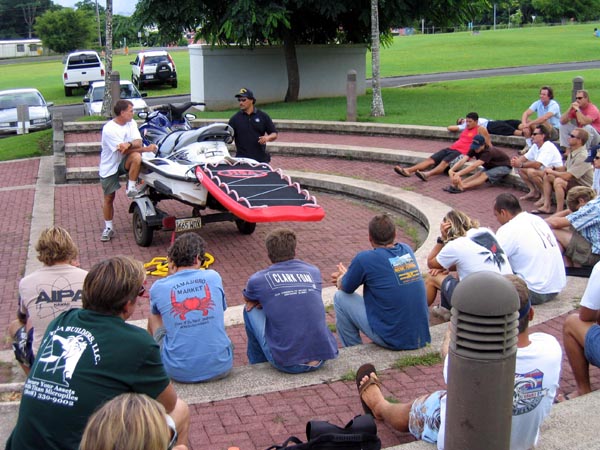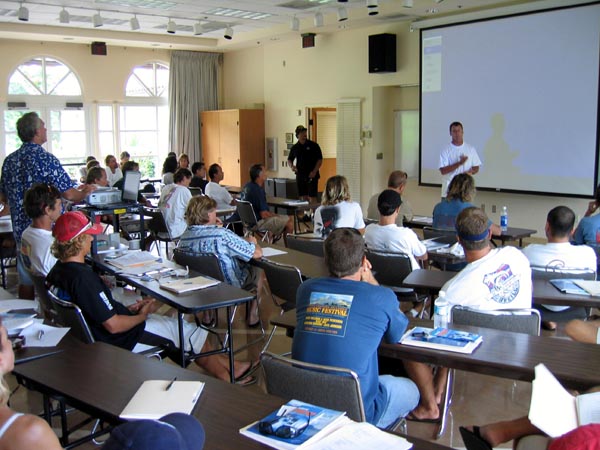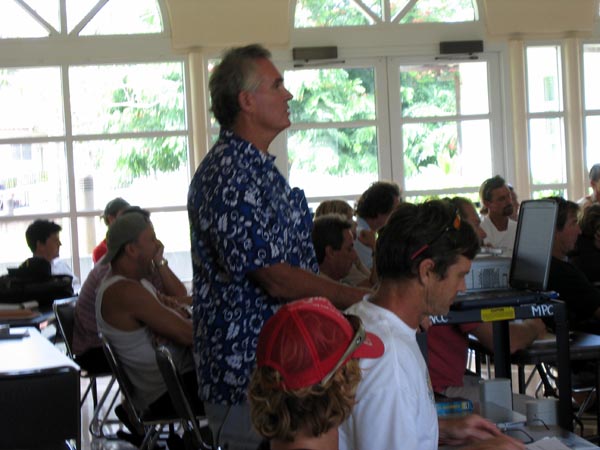Teaching about Tow-in: The Ocean Safety Educational Course (10/4/04)
I wrote this for Mike Latronic's Free Surf magazine. Had to do it fast, but the interview and subsequent story was very rewarding. By Neal Miyake On September 1, 2004, the state's Department of Land and Natural Resources' (DLNR's) Division of Boating and Ocean Recreation enacted rules regulating big wave tow-in surfing in Hawaii. It requires that "thrill craft" operators and tow-in surfers be certified through an accredited course on the safe use and operation of thrill craft in high surf, and that thrill craft be registered with the DLNR. (Complete rules here) This accredited course is entitled "Ocean Safety Educational Course" and is taught through the University of Hawaii system by Jim Howe ( C&C of Honolulu's Ocean Safety and Lifeguard Services Operations Chief), Ken Bradshaw (veteran big-wave tow-in surfer), Brian Keaulana (big wave surfer and expert in ocean safety risk management), and Archie Kalepa (Maui County Ocean Safety Operations Chief), among others. The 10-hour course spans two days, and has been well attended, with classes filled to near capacity. Despite the generic title, the course specifically focuses on the tow-in surfing experience. Topics covered include: legal and regulatory requirements for tow-in surfing in Hawaii, basic CPR and first aid techniques, tow-in equipment overview, fitness training, in-water etiquette, jetski operation and safety techniques, ocean safety practices and scenario studies in high surf, endangered species laws, and surfing cultural issues. Although the certification efforts were met with initial skepticism, the classes have since been well received. Said Ken Bradshaw, "Some people, like veteran tow-surfer Darrick Doerner, were skeptical of the idea. However, after going through the course, Darrick fully endorses it, even offering to be a guest lecturer." Jim Howe noted, "Big wave tow-in as a crossover sport, combining elements of boating and surfing. Because of that, it needs to adhere to regulations and etiquettes of both." Howe further explained, "The state has actually provided relief to some of the rules (most notably in access), so it is imperative that tow-in surfers respect and abide by all rules, not just for the safety of themselves and others, but for tow-in surfing's greater reputation and standing in the state." Of course, these regulations and the class didn't just pop up overnight. Bradshaw and many others have been lobbying to establish tow-in surfing as a legitimate pursuit for six years now, attending public hearings and working with various factions to have it accepted into the community. Howe worked with UH to build the course from scratch, legitimizing the certification with the support of experts in the field. Regulation was inevitable, but with the collective efforts of ocean enthusiasts statewide, a reasonable compromise was struck. This is not the case everywhere in the world. Due to a failure to reach an agreement in California, as of now there will essentially be no more tow-in surfing allowed. That means no more towing into Mavericks except for the possibility of two days during the winter for a contest. The Hawaii regulations do have some issues of concern. One item that needs further exploration is the rule that towing can only occur when the National Weather Service (NWS) officially calls a high surf warning (waves 25 feet faces or higher on the north and west facing shores). Last winter, the NWS only declared a high surf warning a handful of times, despite surf reaching that mark on many occasions. Some enthusiasts have also expressed quite openly that providing certification may give people carte blanche to take on big surf despite not having similar paddle-in big wave experience. Bradshaw acknowledged, "We run the chance of falsely empowering people, but the benefits outweigh the risk." Howe added, "The alternative is that people would be out there anyway with no background or any previous knowledge. It is better than nothing." Bradshaw and Howe both hope to impress on the students that this course is only just the beginning of the learning process. A positive spin-off to the certification is an increased safety presence in the ocean. "For the ocean community," Howe opined, "building a commonality of interest in ocean safety for everyone is a side benefit, very similar to the successful junior lifeguard program." Bradshaw amplified that he's rescued dozens of people with his jetski. Having people trained in high surf safety skills with an exceptional ocean safety tool such as a jetski in hand, will make the Hawaiian waters a safer place for all. For more information on classes, on Oahu call (808) 235-7400, on Maui call (808) 984-3401, and on Kauai call (808) 245-8311.
|




